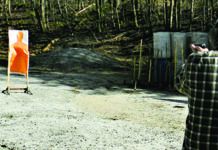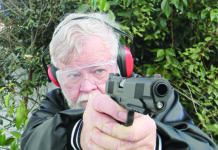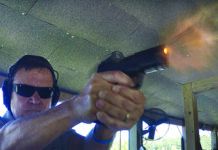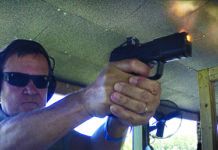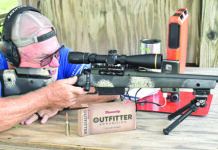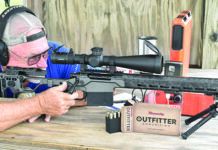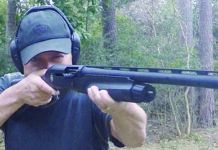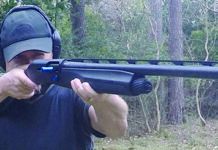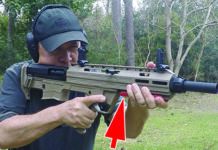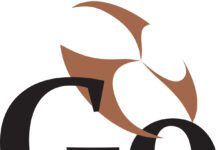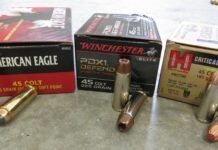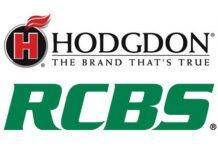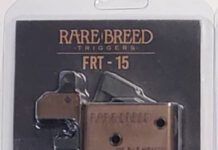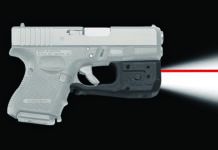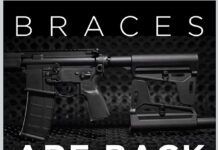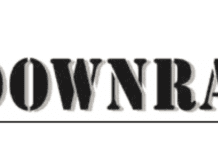There’s a new breed of action rifle in Cowtown. Instead of the diehard lever gun of old, many Cowboy Action shooters looking to shave the last seconds off their time will soon be using a pump rifle. In the quest for speed in that game, top shooters are posting winning scores with the old Colt Lightning design, or clones thereof. Because top shooters use them, that means everybody wants one, whether or not they work better than the ol’ lever action mainstay.
Variety is, of course, what drives the gun industry, and we’re surely not complaining, but we confess we had no idea how well these slide-actions would perform. The original Colt Lightning was made in three sizes, the smaller two being more popular. The medium frame, first of the series, was made from 1884 to 1902, and was offered in .32-20, .38-40, or .44-40 to match popular revolver calibers of the day.
Total quantity made was around 90,000 in the medium frame, which today’s guns copy. Original guns in shootable condition are scarce and costly, but today you can buy a decent copy of the Lightning from several sources, including Taurus, American Western Arms (AWA), USFA, Beretta, and one or two others, and at least one of them is totally affordable. Calibers now include .45 LC and .38/.357, but AWA still offers the original chamberings.
The all-blue AWA Lightning is available in a variety of calibers including .32-20, .38-40, .38 Spl., .44-40, or .45 LC. If you want it with an octagonal barrel in either the test rifle’s 20-inch length or with a 24-inch barrel, the price is $890. Russ Simpson, president of AWA, informed us that there were many options available for original Colt Lightnings, so the crescent butt plate here, and the buckhorn rear sight on the Beretta carbine, might have been found on originals. No originals, however, have been found or documented with color-case hardened receivers.
AWA offers real case hardening (by Doug Turnbull) as a $300 option in either barrel configuration. All the AWA rifles have receivers, trigger guards and other major parts that are machined from forgings. The parts are made by Mateba in Italy for AWA, but assembled in Hialeah, Florida. Stocks are walnut. Our sample had a mighty nice piece of wood on it, which we later found out was an upgrade. You can upgrade in several steps for extra money. There is also a Limited Edition (500 total) being produced largely to the buyer’s individual specifications.
Our initial impression of the AWA was entirely positive, and it pretty much stayed that way. The wood was better than just nice walnut, and carried a decent oil-type finish. It also had extremely nice wraparound checkering on the grip, and two well-done panels on the forend. The forend wood grain matched the butt stock. The butt was fitted with a crescent-shaped plate. All the inletting, metal polishing and bluing were excellent. The left side of the blued action had a tasteful rendition of the company logo laser etched into the flat. The military type sights, such as the one added to this rifle by its owner, were common on original carbine versions of the Lightning, but not always standard. AWAs come with buckhorn sights. Both front and rear sights were set in dovetails in the barrel, adjustable for windage by drifting. The front was a gold-faced bead, and the flat-top, V-notch rear had a flip-up ladder arrangement for longer range. As with the Taurus, there was no distinct elevation control, given a round bead and a V-notch, so the shooter could either place the bead at the bottom of the V or level with the top.
The action cycled easily and smoothly. Loading the AWA was identical with the other two, with the exception that with this rifle we never had a loaded round come back under the carrier. The Beretta gave us fits with this, as you shall see, and we had one instance of it with the Taurus when we first began. But the AWA was, during our testing, free from that trouble. The people behind this concept as done by AWA clearly have a handle on the correct inner workings of the old Colt Lightning. The instruction manual recommended only factory-loaded cowboy-level ammunition. The magazine held ten rounds. The trigger pull was just under four pounds, and free from creep.


